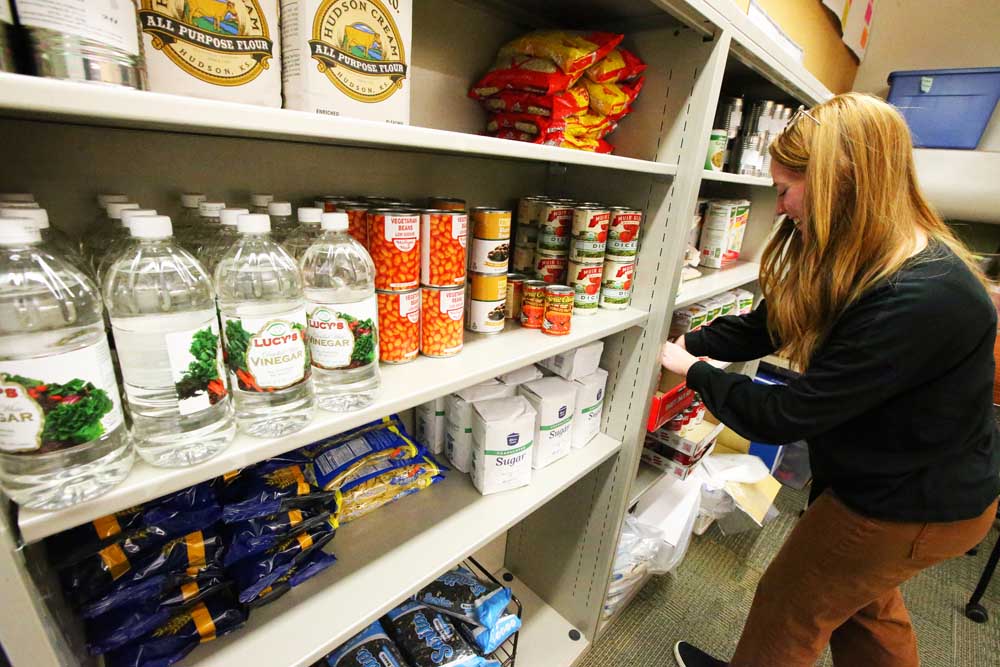Central Oregon Community College expands food pantries to help alleviate student hunger
Published 5:45 am Saturday, December 30, 2023

- Assistant Director of Student Life Lindsay Buccafurni organizes food bank items, which are available to students in need, in the Student Life Office at the Coats Campus Center on the Central Oregon Community College Bend campus on Dec. 19.
Students experiencing food insecurity are increasingly turning to on-campus food pantries – free donation centers that provide personal hygiene products and essential kitchen staples, like pasta and vegetables.
For some, it’s these food pantries that buffer the worst consequences of hunger and poverty. Still, as pandemic-era safety net programs expire and the cost of groceries climbs with inflation, the demand for donations at food pantries is only rising.
Central Oregon Community College’s food pantry program began modestly a decade ago. With the expansion of nonprofit partnerships, grants and the support of the student government, the college has been able to expand the program to all of its four campuses in Bend, Redmond, Prineville and Madras.
This year, more students at Central Oregon Community College sought out food in the first two weeks of classes “than we had in the entire last month of spring term last year,” said Alicia Moore, the vice president of student affairs at the college.
Research published this year in the Journal of Hunger and Environmental Nutrition notes that 44% of college students across the country face food insecurity, and a lack of food diminishes a student’s ability to focus on academics. It’s these support programs, Moore said, that can determine whether a student completes a degree or must face the prospect of dropping out.
Some of the financial support for the college’s food bank comes from the student government, which approved the allotment of student fees to fund the program independently of tuition revenue. Supporting the food pantry is one of the highest priorities, said Mal Sotelo, a sophomore at Central Oregon Community College and the student body president.
Grants from nonprofits and private contributions also help support the program. All said and done, it costs on average $4,500 a month to sustain the program, said Jennifer Kovitz, a spokesperson for Central Oregon Community College.
In less than a year in 2023, Central Oregon Community College invested more than $50,000 in replenishing its food pantries across its campuses, according to Kovitz.
At the Bend campus alone, the college provided nearly 12,000 pounds of food and received another 10,000 pounds of food from NeighborImpact, a nonprofit that provides food and rental assistance.
How often, and how many students use the food pantries can be difficult to track. Still, Moore estimates that around 300 students use the college’s food pantries. The benefit of the food assistance extends beyond the students, too, as many bring food home to help support their families. Some of the students at Central Oregon Community College balance their academic goals with raising a family, and it’s not uncommon for students to pick up diapers at the food pantry, said Sotelo.
Sotelo recognizes that it’s beyond the capacity of the student government to provide three meals a day to everyone in need, but the organization is going to continue providing as much support as it can, for as long as it can. Once, Sotelo was brought to tears after she and other members of the student government received thank you notes from a student who relied on the food pantry.
Moore discourages stereotypes that typecast community college students as “lesser” than their university counterparts. Still, she recognizes that many community college students can face steeper financial barriers that prevent them from pursuing higher education.
Around one-third of students attending Central Oregon Community College qualify for Pell grants, federal assistance for undergraduate students with exceptional financial need that can cover the full cost of tuition.
To foster an educated workforce and promote career advancement, it’s crucial to provide comprehensive support to these students, Moore said. This becomes especially important for those underrepresented in academic settings, including families, students of color and veterans, who may face additional barriers hindering their access to education.
It might sound cliche, Moore said, but “it’s not a handout, it’s a hand up. It’s about ensuring students have equitable access to the resources to allow them to be successful.”
What can you do if you suspect someone doesn’t have enough food?
The food pantries in Central Oregon all are low-barrier, meaning no paperwork is required to prove need. Anyone can go to a food pantry and shop for free food and can even get food for others. The only information required is name, ZIP code, number of people living in the home and a signature. Go to www.neighborimpact.org/providers/ for a list of food pantries in Central Oregon. The website can filter information by language and geography.
Series: Hunger in Central Oregon
One in 5 residents of Central Oregon is hungry too often. Civic leaders, organizations and volunteers fighting to solve the problem say hunger goes deeper than most people are aware. The Bulletin is shining a light on the situation and the community’s efforts to address it. Previously published stories in the series are:
Dec. 19
• Hunger in Central Oregon: Food security is more than subsistence: the changing reality of hunger
• Food banks: Myriad options in Central Oregon for donating to food banks
Dec. 20
• Helping seniors: From prison with love: Deer Ridge inmates cook meals for Madras seniors
Dec. 21
• Growing up hungry: How is Central Oregon helping its hungry children?
Dec. 22
• Finding comfort with food: Neighbor of Bend senior center finds solace in baking
Dec. 23
Helping others: In the face of insults and threats, Prineville woman vows to feed the needy
Dec. 26
PHOTOS: See how food goes from Central Oregon’s leading food bank to residents
Dec. 27
Hunters help the hungry: Central Oregon food banks accept donated game meat from hunters
Dec. 28
Homelessness and hunger: Homelessness makes being hungry even harder, and there aren’t enough resources
Dec. 29
Crook County’s food desert: Rural Crook County residents grapple with food insecurity with help from near and far
Series: Hunger in Central Oregon
One in 5 residents of Central Oregon is hungry too often. Civic leaders, organizations and volunteers fighting to solve the problem say hunger goes deeper than most people are aware. The Bulletin is shining a light on the situation and the community’s efforts to address it.
• Hunger in Central Oregon: Food security is more than subsistence: the changing reality of hunger
• Food banks: Myriad options in Central Oregon for donating to food banks
• Helping seniors: From prison with love: Deer Ridge inmates cook meals for Madras seniors
• Growing up hungry: How is Central Oregon helping its hungry children?
• Finding comfort with food: Neighbor of Bend senior center finds solace in baking
• Helping others: In the face of insults and threats, Prineville woman vows to feed the needy
• PHOTOS: See how food goes from Central Oregon’s leading food bank to residents
• Hunters help the hungry: Central Oregon food banks accept donated game meat from hunters
• Homelessness and hunger: Homelessness makes being hungry even harder, and there aren’t enough resources
• Crook County’s food desert: Rural Crook County residents grapple with food insecurity with help from near and far








